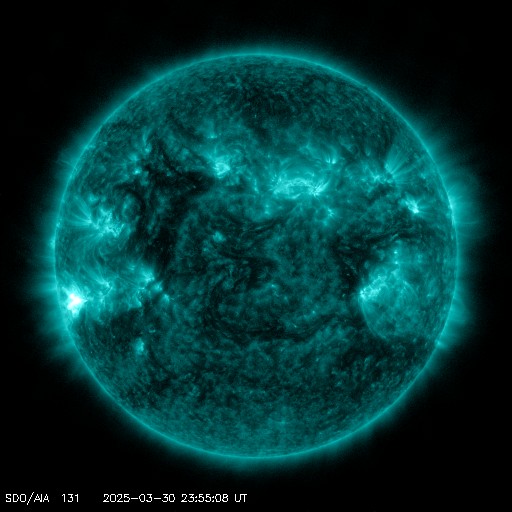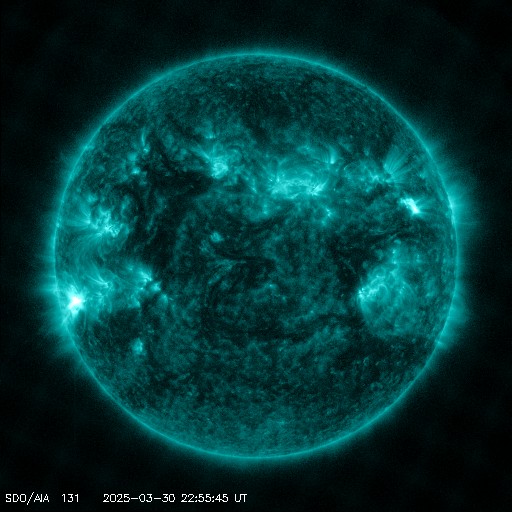Viewing archive of Tuesday, 9 August 2011
Solar activity report
Any mentioned solar flare in this report has a scaling factor applied by the Space Weather Prediction Center (SWPC). Because of the SWPC scaling factor, solar flares are reported as 42% smaller than for the science quality data. The scaling factor has been removed from our archived solar flare data to reflect the true physical units.
Report of Solar-Geophysical Activity 2011 Aug 09 2200 UTCPrepared by the NOAA © SWPC and processed by SpaceWeatherLive.com
Joint USAF/NOAA Report of Solar and Geophysical Activity
SDF Number 221 Issued at 2200Z on 09 Aug 2011IA. Analysis of Solar Active Regions and Activity from 08-2100Z to 09-2100Z
Solar activity was high. Region 1263 (N17W83) produced
an X6/2b flare at 09/0805Z, the largest x-ray event so far in Cycle
24. This flare was accompanied by multi-frequency radio emissions,
including a Tenflare (710sfu), and Type II (1551 km/s) and IV
signatures. A full halo CME was subsequently observed in LASCO C3
imagery at 09/0906Z. Initial plane-of-sky speed was estimated to be
about 1000 km/s. Earlier in the period, a CME was observed in LASCO
C3 imagery at 0406Z. This event was attributed to an M2/1b flare
from Region 1263 at 09/03435Z. While the area of Region 1263
diminished over the last 24 hours, the longitudinal extent expanded,
and the region ended the period as an Ehc type spot group with a
beta-gamma-delta magnetic configuration.
IB. Solar Activity Forecast
Solar activity is likely to be low to
moderate. A slight chance for an isolated X-class flare, and/or
proton event, remains for Day 1 (10 August). Event probabilities are
expected to gradually decrease as Region 1263 rotates around the
west limb.
IIA. Geophysical Activity Summary 08-2100Z to 09-2100Z
The geomagnetic field was quiet to unsettled through the period under
the continued influence of a coronal hole high speed stream. Solar
wind speed at the ACE spacecraft was approximately 600 km/s for most
of the period. The Bz component of the interplanetary magnetic
field was predominantly near zero. The greater than 100 MeV protons
crossed the 1 pfu event threshold at 09/0825Z, reached a maximum of
2 pfu at 09/0855Z, and ended at 09/1045Z. The greater than 10 MeV
protons crossed the 10 pfu event threshold at 09/0845Z, reached a
maximum of 26 pfu at 09/1210Z, and ended at 09/1715Z. The greater
than 2 MeV electron flux at geosynchronous orbit reached high levels
during the period.
IIB. Geophysical Activity Forecast
The geomagnetic field is
expected to be predominantly quiet to unsettled for the next three
days (10-12 August). Unsettled conditions are expected on Day 1 (10
August) as a weak remnant of the 08 August CME arrives. Currently,
a return to mostly quiet conditions is expected on Days 2 and 3
(11-12 August). Analysis of the 09/0906Z CME is presently underway
to determine its potential geoeffectiveness.
III. Event Probabilities 10 Aug to 12 Aug
| Class M | 60% | 40% | 20% |
| Class X | 10% | 10% | 05% |
| Proton | 99% | 60% | 10% |
| PCAF | Yellow | ||
IV. Penticton 10.7 cm Flux
Observed 09 Aug 098 Predicted 10 Aug-12 Aug 095/085/085 90 Day Mean 09 Aug 096
V. Geomagnetic A Indices
Observed Afr/Ap 08 Aug 008/010 Estimated Afr/Ap 09 Aug 008/008 Predicted Afr/Ap 10 Aug-12 Aug 010/010-007/007-005/005
VI. Geomagnetic Activity Probabilities 10 Aug to 12 Aug
| A. Middle Latitudes | |||
|---|---|---|---|
| Active | 20% | 15% | 05% |
| Minor storm | 05% | 05% | 05% |
| Major-severe storm | 01% | 01% | 01% |
| B. High Latitudes | |||
|---|---|---|---|
| Active | 15% | 20% | 10% |
| Minor storm | 10% | 05% | 05% |
| Major-severe storm | 05% | 05% | 01% |
All times in UTC
Current data suggests there is a slight possibility for aurora to appear at the following high latitude regions in the near future
Whitehorse, YT, Yellowknife, NTFairbanks, AK
Latest news
Latest forum messages
Solar Demon 3Unspecified geomagnetic activity 2146AR4046 134Aurora photography hints for those of us with smartphones 54AR4048 34
More topicsSupport SpaceWeatherLive.com!
A lot of people come to SpaceWeatherLive to follow the Sun's activity or if there is aurora to be seen, but with more traffic comes higher server costs. Consider a donation if you enjoy SpaceWeatherLive so we can keep the website online!

Latest alerts
00:09 UTC - Solar flare
Moderate M1.03 flare
Sunday, 30 March 2025
23:51 UTC - Radio Blackout
Minor R1 radio blackout in progress (≥M1 - current: M1.03)
23:39 UTC - Solar flare
Moderate M1.52 flare
23:21 UTC - Radio Blackout
Minor R1 radio blackout in progress (≥M1 - current: M1.49)
23:09 UTC - Solar flare
Moderate M1.48 flare
Space weather facts
| Last X-flare | 2025/03/28 | X1.1 |
| Last M-flare | 2025/03/30 | M1.0 |
| Last geomagnetic storm | 2025/03/27 | Kp5 (G1) |
| Spotless days | |
|---|---|
| Last spotless day | 2022/06/08 |
| Monthly mean Sunspot Number | |
|---|---|
| February 2025 | 154.6 +17.6 |
| March 2025 | 127 -27.6 |
| Last 30 days | 127 -25.7 |





